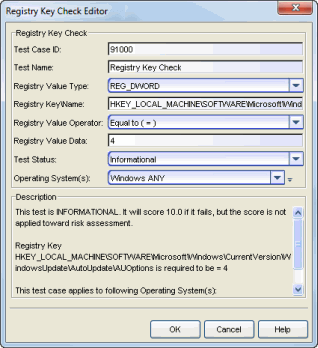This window lets you configure parameters for a Registry Key Check test case included in an agent-based test set. This test checks to see if the end-system has one specific Windows registry key. If you would like to create a test that checks for multiple registry keys, use the Registry Key Check Advanced Editor.
Click areas in the window for more information.

- Test Case ID
- The test case is automatically assigned a Test Case ID number, although you can change this number, if desired. You can refer to this Test Case ID number when creating scoring overrides or looking at the Health Result Details Tab in the End-Systems tab.
- Registry Value Type
- Select the registry value type from the following options:
- REG_SZ (STRING)
- REG_DWORD
- REG_BINARY
- KEY EXISTS - checks to see if the registry key is installed
- KEY NOT EXIST - checks to see if the registry key is not installed
- Registry Key Name
- Enter the Registry Key\Name using the format shown in the following
example:
HKEY_LOCAL_MACHINE\SOFTWARE\Microsoft\Windows\CurrentVersion\WindowsUpdate\AutoUpdate\AUOptions
If you are verifying that a folder exists in the registry (a default registry entry) the Registry Key Name must end with either (Default) or \\, as shown below:
HKEY_LOCAL_MACHINE\SOFTWARE\WinPcap\(Default)
HKEY_LOCAL_MACHINE\SOFTWARE\WinPcap\\
| NOTE: | The Registry Key check does not currently support checking for the
Multi-String, Expandable String, and QWORD registry key values. |
|---|
- Registry Value Operator
- Select the Registry Value Operator (not used for KEY EXISTS and KEY NOT EXIST options).
- Registry Value Data
- Enter the Registry Value Data (not used for KEY EXISTS and KEY NOT EXIST options).
- Test Status
- Use the Test Status drop-down list to specify a status for this
test. The status determines how the score returned by the assessment
test will be used.
- Disabled - The test will not be run.
- Informational - The test will be run and test score results will be reported, but are not applied towards a quarantine decision. No end-systems will be quarantined.
- Warning - Test score results are only used to provide end user assessment warnings via the Notification portal web page. No end-systems will be quarantined unless a grace period (if specified) has expired.
- Mandatory - Test score results will be included as part of the quarantine decision, and end-systems can be quarantined. If the status is Mandatory, the end-system will fail the test if the registry key is not found or if the registry key is found, but the value does not match. For the KEY EXIST and KEY NOT EXIST options, if the status is Mandatory, the end-system will fail the test if the registry is found or not found respectively.
- The default scoring for agent-based tests is 0 for pass and 10 for fail. You can use scoring overrides if you wish to customize the default scoring.
- Operating System(s)
- Use the checkboxes in the drop-down list to select the operating
systems that this test case will apply to. This list is automatically
populated with all the operating systems on which this test can be
performed.
 Use the
configuration menu button to open the Manage Operating Systems window where you can
add a new operating system for selection. For example, you may want to
add a Windows operating system with a different service pack
requirement.
However, keep in mind that any changes you make will only be reflected in the
drop-down selection list as long as they are supported by the test.
Use the
configuration menu button to open the Manage Operating Systems window where you can
add a new operating system for selection. For example, you may want to
add a Windows operating system with a different service pack
requirement.
However, keep in mind that any changes you make will only be reflected in the
drop-down selection list as long as they are supported by the test.
For information on related topics: